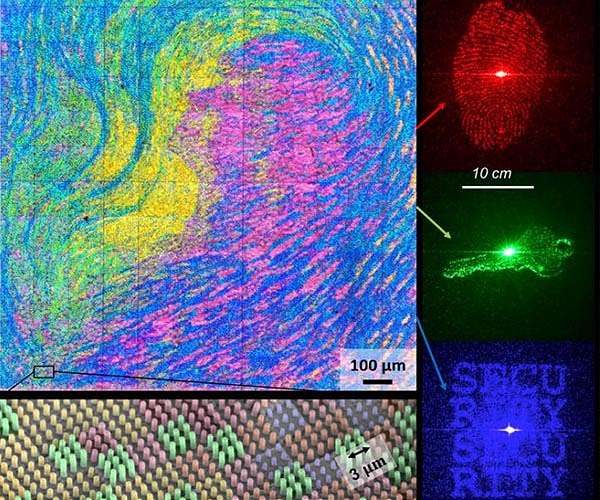Researchers from the Singapore University of Technology and Design (SUTD) have developed an anti-counterfeiting device using nano 3D printed polymer structures.
Leading the research, Joel Yang, Associate Professor in Engineering Product Development at SUTD, and his team dubbed their invention “holographic color prints.” The study published in scientific journal Nature Communications, states:
“Conventional optical security devices provide authentication by manipulating a specific property of light to produce a distinctive optical signature. Microscopic color prints modulate the amplitude, whereas holograms typically modulate the phase of light. However, their relatively simple structure is easily imitated.”
“We designed a pixel that overlays a structural color element onto a phase plate to control both the phase and amplitude of light, and arrayed these pixels into monolithic prints that exhibit complex behavior.”

Holographic color prints
In order to create holographic color prints that are difficult to emulate, the research team developed a holographic color pixel that controls both the phase and amplitude of light. The optical device is visible as a color print under white light but projects up to three different images onto a distant screen when lit up with laser pointers.
The 3D microprinting process, two-photon lithography, was implemented due to its capability of additively manufacturing features that are much smaller than the resolution of the laser beam curing source.
This is enabled by a lens/glass plate arrangement that filters the laser into a fine focal spot. The study adds, “As our pixel has a relatively large minimum feature size of several hundreds of nanometers and consists entirely of a single dielectric material, we are able to fabricate it with femtosecond 3D printing as a monolithic structure in a cross-linked polymer.”
“These holographic color prints are readily verified but challenging to emulate. As the prints encode information only in the surface relief of a single polymeric material, nanoscale 3D printing of customized masters may enable their mass-manufacture by nanoimprint lithography.”

Combating counterfeits with 3D printing
“The relationship of holograms in combating counterfeiting is analogous to antibiotics against infections. Every so often, new technology is needed to deter counterfeiters as the old fashioned holograms become easier to copy,” explained Professor Yang.
The holographic color prints incorporate a new type of nanostructured pixels which act as speed bumps (phase control) and roadblocks (amplitude control) for light, thus, deterring counterfeiting.
“For the first time, multiple holograms that are color selective are ‘woven’ into a colorful image using advanced nanofabrication techniques. We are hopeful that these new holographic color prints are user-friendly but counterfeiter unfriendly: They are readily verified but challenging to copy, and can provide enhanced security in anti-counterfeiting applications.”
Similarly, last year, Nanoscribe developed a new method for creating microscopic security features for security tags, named multi-level diffractive optical elements (DOEs) which also uses two-photon lithography.
The research paper, “Holographic colour prints for enhanced optical security by combined phase and amplitude control” is co-authored by Kevin T. P. Lim, Hailong Liu, Yejing Liu, and Joel K. W. Yang.

Nominate for the upcoming 3D Printing Industry Awards 2019.
For the latest 3D printing research, subscribe to the 3D Printing Industry newsletter, follow us on Twitter and like us on Facebook.
Seeking a fresh start in the new year? Visit 3D Printing Jobs to commence your career in additive manufacturing.
Featured image shows Holographic projections of the print in transmission, photographed on a white wall in a darkened room. Image via SUTD.


